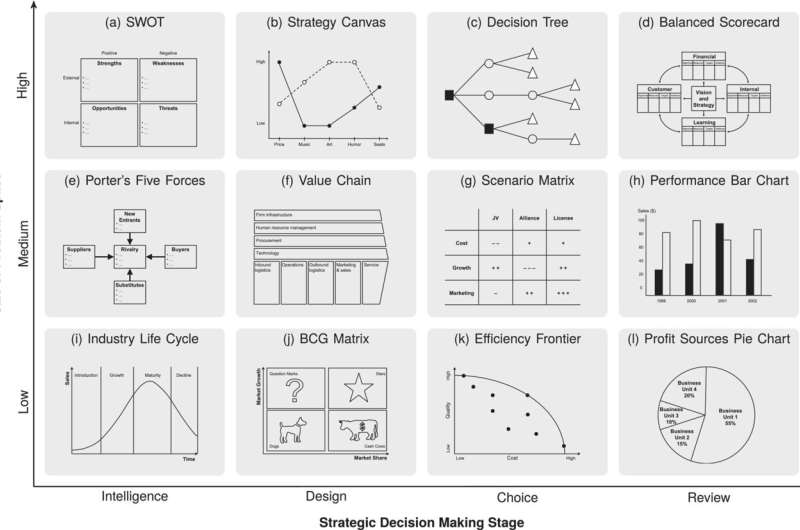This article has been reviewed according to Science X's editorial process and policies. Editors have highlighted the following attributes while ensuring the content's credibility:
fact-checked
peer-reviewed publication
trusted source
proofread
Research reveals visuals' crucial role in strategic decision-making

Management consultants and professors seem to be obsessed with visuals. When it comes to strategy, they either pull out their impeccable slides, replete with graphics ranging from a SWOT analysis to Porter's Five Forces to the Strategy Canvas, or they pick up a marker to sketch out their own frameworks on a whiteboard.
This phenomenon has piqued the interest of Felipe Csaszar, professor of strategy at the University of Michigan's Ross School of Business. Csaszar and colleagues Nicole Hinrichs of EHL Hospitality Business School in Switzerland and Mana Heshmati of the University of Washington set out to investigate the role of visuals in strategic decision-making processes.
Their research, published in the Strategic Management Journal, not only sheds light on why visuals are pervasive in strategy, but also reveals how visuals significantly impact decision quality.
Drawing on insights from cognitive science and organization theory, the study finds that visuals play a crucial role in improving four cognitive functions essential for solving strategy problems.
"They include working memory, long-term memory, pattern recognition, and knowledge transfer and transformation," Hinrichs said.
Csaszar says that employing visuals while solving a strategy problem resembles expanding a computer's memory, allowing it to process more data and generate more accurate results. Without visuals, comparing the pros and cons of alternative scenarios could lead to errors due to the limits of human working memory.
Further, strategy problems are often multidimensional, posing a challenge for managers to remember which dimensions to consider. Visuals serve as mnemonic devices, aiding managers in remembering these dimensions—for instance, the graphical form of Porter's Five Forces helps their recall.
In addition, visuals assist in pattern recognition, such as when displaying sales as a graph facilitates the detection of trends. Visuals also enhance knowledge transfer by offering succinct and adaptable formats for expressing and absorbing complex information. Lastly, they foster the co-creation of new knowledge by bridging differences and creating a shared understanding among individuals with diverse perspectives.
The study also finds that visuals not only serve as tools to assist managers in navigating the complex and high-stakes nature of strategy decisions but also influence the quality of decision-making.
"Visuals with greater usability and malleability are more likely to help experienced managers identify superior solutions," Heshmati said.
Usability refers to the extent to which helpful information can be extracted from visuals and depends on two mechanisms: pre-attentive processing, which allows users to quickly detect patterns without conscious attention, and Gestalt principles, which help resolve ambiguities in visuals.
An example of a visual with high usability is the Strategy Canvas, which is used to compare the value proposition of firms. On the other hand, malleability is the extent to which it can be changed by those using it.
"Visuals are not mere decoration," Csaszar said. "Instead, they are powerful thinking tools that can enhance users' cognitive capabilities and aid in developing high-quality strategies."
Embracing visuals when making strategic decisions can lead to better decisions, and incorporating visuals when teaching strategy can facilitate understanding, retention and application of strategy concepts, fostering student development and strategic thinking.
Currently, the use of visuals in strategy mainly relies on traditional tools like paper, pen, markers and whiteboards. However, with the rise of new technologies such as artificial intelligence and virtual reality, there's potential to revolutionize this process. AI has the capability to analyze data and generate insights that can be integrated into visuals.
"Think about comparing pros and cons," Csaszar said. "AI can gather relevant information, merge inputs from different sources, and even suggest specific frameworks. It's both efficient and informative."
Virtual reality may allow for immersive and interactive visuals, which can contain more data yet still convey insights and allow for more and better collaboration.
While incorporating visuals into strategy carries many benefits, it is important to recognize that visuals can also pose risks. They may complicate decision-making by obscuring essential details or oversimplifying complex issues. Moreover, visuals can be manipulated in ways that benefit specific actors rather than the whole organization.
"Given that much is at stake when making strategic decisions, a nuanced understanding of how visuals shape decision processes is crucial," Csaszar said.
More information: Felipe A. Csaszar et al, External representations in strategic decision‐making: Understanding strategy's reliance on visuals, Strategic Management Journal (2024). DOI: 10.1002/smj.3613
Journal information: Strategic Management Journal
Provided by University of Michigan





















